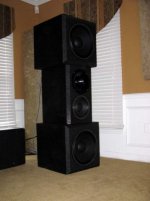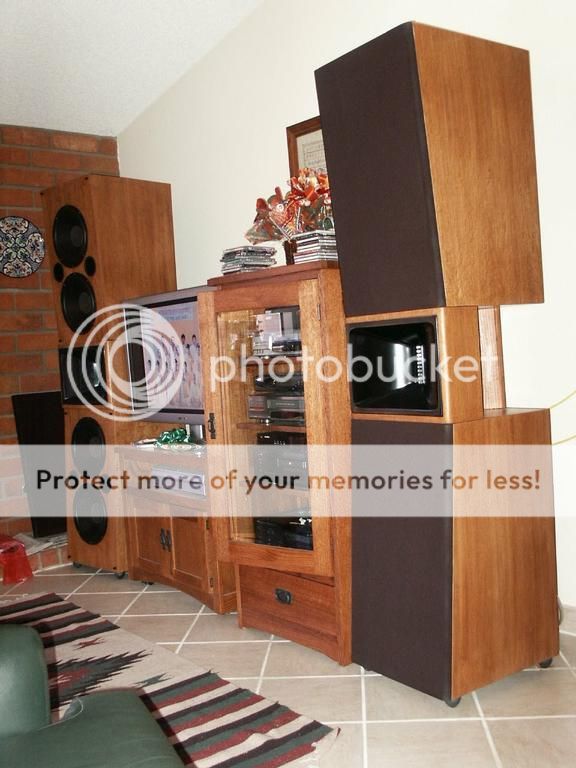Attached.. Quite pure resistive load.
Nothing like resonances, look second attachment (time axis in periods..)
It is very simple to use ordinary attenuation for TPL , without any degradation. In real use it is working with very low power levels, so all distortions remain very, very low (even IMD or multitone), sound is very transparent.
Low distortion also near 100Hz for this "midrange" is important with simple 6dB/octave crossover, here is a lot of power at higher SPL. The same is valid for 2" voice coil (low power compresion) and VC with higher diameter better "supports" cone, it helps to ensure better cone stifness.
Then perhaps someone can shed some light on this: http://www.diyaudio.com/forums/planars-exotics/221279-tpl150-diy.html#post3198340
As I understand it, the measurements are of a standard TPL150H with rear chamber and felt removed.
One advantage of using a large-format mid driver is to have most of the vocal range covered by a single driver, which almost makes the Beyma TPL-150/mid driver combo (if the drivers are mounted as close as possible on the baffle) constitute a "point source".
that is exactly one of the big advantages.
Two days ago i went with a friend to have a listen at someones home, that had the Wilson Alexandrias with big Pass amps. The distance of emission between the 10" lower midrange, and the tweeter, in particular, was well perceived. No coherence and sinergy between the different channels. With the TPL150/12p80nd, you have a very broad frequency range fully covered, almost
like a point source, and furthermore, using the tpl-150 bipole, you get wonderful spaciality. Only add a sub, and you have a speaker system, hard to beat.
I however do not like just one woofer reproducing the low frequency range.
Like with the Alexandria, the bass energy was coming all only from the lower part close to the floor, and the upper part of the room was without bass energy. I missed that immediately. I like homogeneous, undirectional dispersion of bass in the whole room, like at my home. And i think that is more natural.
p.s. Paul Squillo answered me on Facebook :
I can get any size, 800hz, 700hz, 500hz, 400hz (the numbers refer to their recommended crossover points when horn-loaded). Let me know if you want with or without horn, one-direction or dipolar, high efficiency for bi-amping or lower efficiency for passive xovers.
The driver I'm using for my new speaker is a 101dB efficiency 500hz folded ribbon horn with 16x12 horn, is dipolar with a finished rear plate. Based on its manufacturing cost, it should have price of $4300/pr.
that price is not very encouraging......
So maibe, rather than just one woofer below the TPL150/12p80nd combo, a bass row, or Bass, mid/treble, Bass would be most interesting. Like this :
Beyma Woofers, Mids and Compression drivers w/ DDS horns
Attachments
Last edited:
Thank for the TPL DIY mods......they confirm my thoughts about where to cross the TPL upwards of 1.8khz.....and I certainly wouldn't push a 12" mid that high.....but that's just my opinion of course. A 6-8" mid above a JBL 2260.......now we're talking!
crossing the tpl150 at 1,2khz, and i don't hear anything that disturbes me. Are these distortion figures not relevant and depending also on how much power is feeded ? At home, we don't listen with more than a few watts .....
that jbl sub looks so cool :
Speakers: JBL ASB6112 Compact High Power Single 12" Subwoofer
but it seems the woofers alone are not available.
angelo ... have you tried xo @ around 1500hz (mid) and 1800hz(amt) 3rd order electrical with a steep notch on the 12" @ 2500hz? Actual cone diameter is probably closer to 9.5" to 10" on the Beyma mid. Dispersion should be a close match at those frequencies.
I ask because I've used a 12" w/an amt combo with such a xo point ... there about. I did however high pass the mid no lower than 124hz. A 3rd or 4th order elec. bessel filter (around 180-200hz) seemed to provide a very nice effect on voices. Not stressed and very intelligible. My sub is LP'ed at around 124hz or 144hz 3rd order with such an arrangement. Depends on how much bass you want.
I ask because I've used a 12" w/an amt combo with such a xo point ... there about. I did however high pass the mid no lower than 124hz. A 3rd or 4th order elec. bessel filter (around 180-200hz) seemed to provide a very nice effect on voices. Not stressed and very intelligible. My sub is LP'ed at around 124hz or 144hz 3rd order with such an arrangement. Depends on how much bass you want.
angelo ... have you tried xo @ around 1500hz (mid) and 1800hz(amt) 3rd order electrical with a steep notch on the 12" @ 2500hz? Actual cone diameter is probably closer to 9.5" to 10" on the Beyma mid. Dispersion should be a close match at those frequencies.
I ask because I've used a 12" w/an amt combo with such a xo point ... there about. I did however high pass the mid no lower than 124hz. A 3rd or 4th order elec. bessel filter (around 180-200hz) seemed to provide a very nice effect on voices. Not stressed and very intelligible. My sub is LP'ed at around 124hz or 144hz 3rd order with such an arrangement. Depends on how much bass you want.
Do you have a crossover schematic with the values of the components ? i might try it out......
Active here.Do you have a crossover schematic with the values of the components ? i might try it out......
This is what I have currently. Does anyone have their own measurements of the 12P80Nd? I did a crude "in room" measurement with a cheap mic and didn't find the huge ~2kHz peak shown on the datasheet.angelo ... have you tried xo @ around 1500hz (mid) and 1800hz(amt) 3rd order electrical with a steep notch on the 12" @ 2500hz? Actual cone diameter is probably closer to 9.5" to 10" on the Beyma mid. Dispersion should be a close match at those frequencies.
These are by far the best speakers I have ever heard: My latest and largest HE speaker build
I listened to them without the central subwoofer and after the 10" was replaced with a 10MWNd.
The bass drivers are 15P80Nd.
bad link:-
I listened to them without the central subwoofer and after the 10" was replaced with a 10MWNd.
The bass drivers are 15P80Nd.
bad link:-
An externally hosted image should be here but it was not working when we last tested it.
Last edited:
These are by far the best speakers I have ever heard: My latest and largest HE speaker build
I listened to them without the central subwoofer and after the 10" was replaced with a 10MWNd.
The bass drivers are 15P80Nd.
bad link:-
An externally hosted image should be here but it was not working when we last tested it.
these must me indeed something very special. According to some comments, the 15p80nd has not much lower bass output. Otherwise, it would be the ideal complement to 12p80nd. And the 18p80nd is too big.....
that comment :
They will never play down to that frequency, but I like to do that because it allows the midrange to breathe a bit
makes sense to me. More coherence , and making one speaker cover the whole voice frequency range is a big advantage.
Last edited:
Believe me, these speakers had no trouble with bass. They are the most accurate I've heard from a bass reflex design. The two enclosures have a different tuning frequency which was very good decision.these must me indeed something very special. According to some comments, the 15p80nd has not much lower bass output.
I really think it is worth trying to keep it 2-way. I think the 12P80Nd has good low frequency potential in the right enclosure.
any suggestion ?
2 x BG Neo10 side-by-side for a square shaped 10 incher?
New 2013 Beyma TPL drivers
http://profesional.beyma.com/ingles/pdf/TPL150S.pdf
http://profesional.beyma.com/ingles/pdf/TPL150B.pdf
Just noticed the new TPL drivers.
Cheers
Derek.
http://profesional.beyma.com/ingles/pdf/TPL150S.pdf
http://profesional.beyma.com/ingles/pdf/TPL150B.pdf
Just noticed the new TPL drivers.
Cheers
Derek.
http://profesional.beyma.com/ingles/pdf/TPL150S.pdf
http://profesional.beyma.com/ingles/pdf/TPL150B.pdf
Just noticed the new TPL drivers.
Cheers
Derek.
someone posted the link at my forum. But i have not recognized any difference to the standard one, beside the color of the faceplate......
something like that might be interesting with the beyma combo:
.::W H T L o u d s p e a k e r s - PR4::.
From the impedance curve it looks like the fundamental resonance on the new models may be better damped. Perhaps they used a different flow resistor on the rear. The new impedance curve also lacks the peak just below 20kHz.
Otherwise it seems just cosmetic, although I remember Beyma stating some time ago that a higher power version will be announced.
Otherwise it seems just cosmetic, although I remember Beyma stating some time ago that a higher power version will be announced.
http://profesional.beyma.com/ingles/pdf/TPL150S.pdf
http://profesional.beyma.com/ingles/pdf/TPL150B.pdf
Just noticed the new TPL drivers.
Cheers
Derek.
Beyma Professional Loudspeakers
Last but not least, also is introduced an improvement of Beyma’s pleated diaphragm tweeter with two different finishing, the new TPL-150S and TPL150B, offering anodized aluminium finishing with the possibility of choosing between two options, black or metal.
Sad. I was hoping they would come up with a new and improved amt, that extends down at least to 500hz.
Its a pity thatHawthorn audio do not sell hiwhorn AMT - it can go down to 500Hz So at 800Hz for example you have much more op tions to mate with sensetive PRO midbasses 10-12 inches.PHP:
Why not make a ribbon subwoofer like Transmission Audio.
Last edited:
Hi Angelo,
I agree with StigErik ( only fools disagree!),
Use the Beyma horn (or the Autotech Polish horn) for the TPL, crossover at 1.8KHz or there abouts, any lower and it sounds a bit stressed.
This sadly eliminates a 12 inch mid bass as it will beam too much up high.
How much of a real world issue is this mismatch in dispersion really? OK it is not ideal, on that we can all agree, but how much does it actually impact the sound negatively, if you could quantify it as a percentage of the overall quality of the presentation? Is it 5% or is it 35%? What does this problem actually sound like in the frequency band where it is a problem, i.e. from where the 12" woofer starts to beam till where the TPL-150H takes over, especially for listeners slightly off-center (e.g. in a home theater environment)? And how sensitive is our hearing at the relevant frequencies - perhaps we can't really tell there's a problem?
These two drivers seem to match each other rather well from a sound quality perspective, and it would be a shame if they shouldn't be used together; So is this gap in their optimal passbands a real deal breaker for the more discerning listener or is its importance completely overblown on forums like these, scaring people off from trying out, on purely academic grounds. what would otherwise be a fantastic listening experience?!
By the way, StigErik used the TPL-150H down to approximately 900 Hz to meet a 15P80Nd in his InConcert Miles, which design a lot of people seem to like and enjoy
Last edited:
- Home
- Loudspeakers
- Multi-Way
- Beyma 12P80ND + TPL-150


